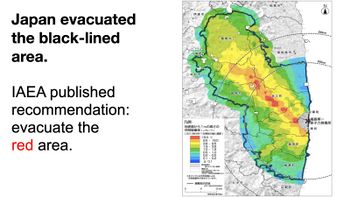Fear of radiation: Difference between revisions
imported>David MacQuigg (Add statement about medical exposures.) |
imported>David MacQuigg mNo edit summary |
||
| Line 6: | Line 6: | ||
{{Image|Electrify5Radiophobia.009.jpeg|right|350px|Fig.3 Natural breakage and repair of our DNA occurs much faster than damage from low levels of radiation.}} | {{Image|Electrify5Radiophobia.009.jpeg|right|350px|Fig.3 Natural breakage and repair of our DNA occurs much faster than damage from low levels of radiation.}} | ||
Over reliance on the LNT model has led to policies that are very costly, like radon remediation in old homes (Fig.4) {{Image|Electrify5Radiophobia.028.jpeg|right|350px|Fig.4 Add image caption here.}} and over-reaction to radiation accidents, like the evacuation after Fukushima, which caused far more deaths that the accident itself (Fig.5). It has also led to excessive fear of radiation from medical x-rays and other procedures which save thousands of lives. | Over reliance on the LNT model has led to policies that are very costly, like radon remediation in old homes (Fig.4) {{Image|Electrify5Radiophobia.028.jpeg|right|350px|Fig.4 Add image caption here.}} and over-reaction to radiation accidents, like the evacuation after Fukushima, which caused far more deaths that the accident itself (Fig.5). It has also led to excessive fear of radiation from medical x-rays and other nuclear medicine procedures which save thousands of lives. | ||
{{Image|Electrify5Radiophobia.014.jpeg|right|350px|Fig.5 Add image caption here.}} | {{Image|Electrify5Radiophobia.014.jpeg|right|350px|Fig.5 Add image caption here.}} | ||
Revision as of 09:53, 24 November 2021
- See also: Nuclear_power_reconsidered

Fig.1 Exposures up to 100mSv in a short time won't overwhelm our immune systems.[1]

Government agencies have for decades assumed that deaths and other bad effects of radiation on our health follow a model called Linear No Threshold (LNT) in which death and disease is simply proportional to the total cumulative radiation, no matter how low the rate, even as low as the normal background radiation from space and the materials around us. This assumption ignores the data on low exposures (Figs.1&2) and the role of DNA repair[3] in mitigating the damage done by low doses of radiation (Fig.3). Without a repair mechanism, the number of DNA breaks would simply accumulate in a linear fashion, no matter how low the exposure.
Over reliance on the LNT model has led to policies that are very costly, like radon remediation in old homes (Fig.4)
and over-reaction to radiation accidents, like the evacuation after Fukushima, which caused far more deaths that the accident itself (Fig.5). It has also led to excessive fear of radiation from medical x-rays and other nuclear medicine procedures which save thousands of lives.
The LNT model has also had a devastating effect on nuclear power. It has lead to the belief that an accident causing a small increase in radiation over a very large area could lead to a large number of cancers and deaths. A more realistic assessment will show that the danger from nuclear power is much smaller than the public believes, and much smaller that the risks from ever-increasing CO2 in our atmosphere.
Further Reading
For a more complete discussion of radiation fear and its impact on public policy and nuclear power, see Section 6 in ElectrifyingOurWorld.com by Robert Hargraves, a founder of ThorCon.
For the pro-LNT point of view, see Hold Fast to Linear No-Threshold for Radiation Protection, Bemnet Alemayehu, Natural Resources Defense Council, 2016.
For a thorough review of the data underlying the LNT controversy, see O'Connor 2017 - Risk of low-dose radiation and the BEIR VII report: A critical review of what it does and doesn’t say, Michael K. O’Connor, Physica Medica 43 (2017) 153-158.


